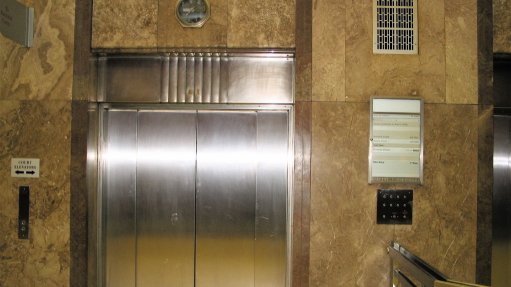
LIFTS INDUSTRY The local lifts industry has to deal with a lack of adequately skilled labour
Photo by: wikimedia commons
South Africa’s lift-servicing industry faces the challenge of not being able to offer all the required service offerings, owing to a lack of highly skilled technicians and an influx of foreign-manufactured products, says lift inspection body Lift Auditor CC owner Willem du Toit.
He tells Engineering News that, although the country’s legislation for vertical transportation, which encompasses lifts, escalators and passenger conveyors, allows for the lift-servicing and inspection sector to thrive, it is limited by the lack of adequate skills to properly service some imported products.
“There are so many types of equipment coming into the country . . . and it has become even more difficult to train technicians in all types of equipment, so most technicians have expert knowledge of certain equipment and limited knowledge of other equipment.”
According to the Occupational Health and Safety Act and the Lift Escalator and Passenger Conveyor Regulations, all forms of vertical transportation equipment must undergo inspection every 24 months.
The regulations also stipulate that a registered lift inspector should inspect any lift that was involved in an incident or an accident before it is used again, as well as newly installed lifts before they are used and those that have been modified. The regulations also state that, when a property owner changes from one lift services provider to another, the building’s lifts should be inspected.
Du Toit explains that after the prescribed inspection, the lift inspector, who must be registered with the Engineering Council of South Africa, must produce a comprehensive report on the state of the inspected lift.
He says that, as an electromechanical device, a lift has a life span of between 20 and 25 years, and some property owners try to use them for longer to save on new installation costs. This only leads to more costs being incurred, as lifts that are operated beyond their life span, subsequently lead to more maintenance and downtime.
“There are lifts in this country that have been in operation for about 30 to 40 years, which is not good for the industry because it has the ripple effect of giving the industry a bad name for not being reliable.
“A lift can only be maintained for so long before its parts become obsolete . . . these lifts that have been running for more than 25 years will always need more than normal maintenance – and that maintenance cannot do much to improve its functionality,” Du Toit explains.
He concludes that Lift Auditor CC has had a retainer contract with University of the Witwatersrand, in Johannesburg, where it inspects the functioning of the university’s lifts. Part of the scope of the contract includes meeting with the university’s lift service providers once a month to discuss the university’s lifts and advising on the state of the lifts.